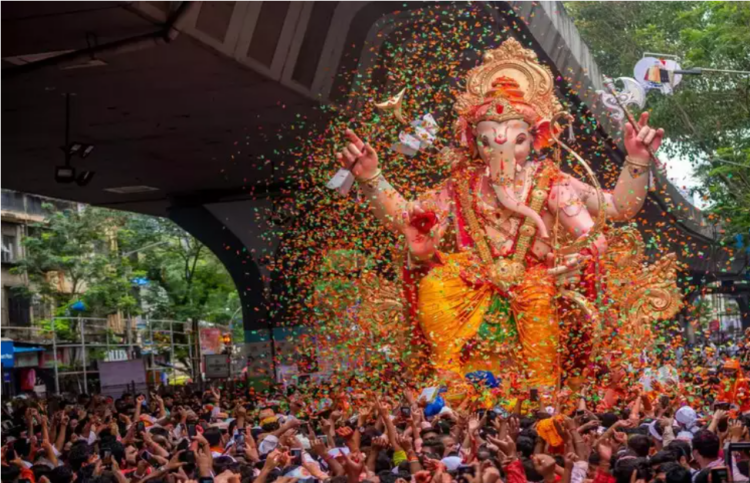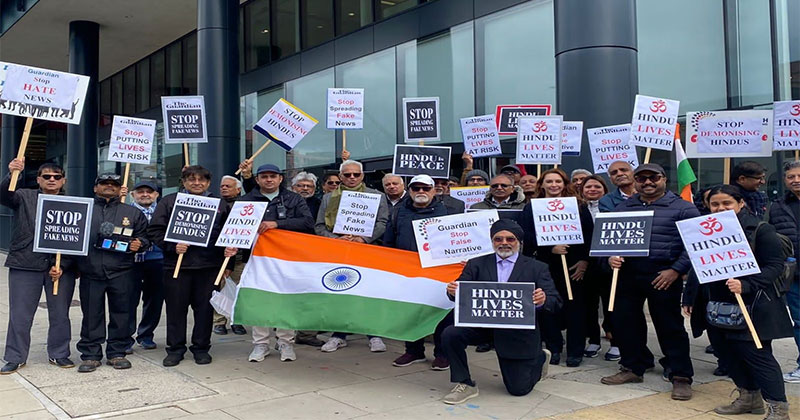In recent years, many Indian companies have started releasing ads with hints of being anti-Hindu just before important Hindu festivals. This year, Parle Company also followed this trend with an advertisement for Ganesh Utsav that seems to question Hindu customs.
The ad, promoting Parle G biscuits, shows a family visiting a sculptor’s workshop to bring home a Ganpati idol for Ganesh Utsav. In the ad, a young girl in the family wants to carry the idol home, but her mother stops her, saying, “Only men are allowed to carry the idol,” and asks her elder cousin brother to do it instead. The boy then asks why his sister and other women can’t carry the idol. The elders explain that it is “traditionally a man’s job” to bring Lord Ganesh home. The ad ends with a change in this tradition, showing the women of the family carrying the Ganesh idol.
The advertisement, crafted by Thought Blurb Communications, is founded on a completely fabricated notion that women are prohibited from bringing Bhagwan Ganesh’s murti (idol) home. For a Mumbai-based agency, this demonstrates a startling level of ignorance and a profound lack of understanding of cultural traditions.
In reality, women actively participate in Dhol-Tasha Pathaks (drum groups) during Ganesh Utsav, energetically engaging in both the welcoming (Agaman) and immersion (Visarjan) of Bhagwan Ganesh. Numerous observations highlight why the advertisement is fundamentally flawed. While public idols (Sarvajanik murtis) are often carried by men due to their weight, there are no rigid rules concerning who can carry residential Ganpatis.
Moreover, Ganpati Bappa (Bhagwan Ganesh) is regarded as an honoured guest, much like a visiting relative, and during the festival, the doors of the house are kept open at all times. Family members staying back are often women who take on responsibilities such as preparing Naivedya Prasad (holy offerings). Women manage household duties and work outside, and they are equally welcome to play Dhol-Tasha. Given these realities, it is implausible to suggest that tradition would bar them from bringing Bhagwan Ganesh home.
These Hinduphobic advertisements are a product of pseudo-secularism and a distorted form of feminism imposed on Hindu society. The primary aim behind creating such an unfounded advertisement appears to be to cast Hindu Dharma in a negative light and falsely accuse it of patriarchy. Contrary to the portrayal in the ad, no tradition denies women the right to carry the idol.
Spate of similar cases
This is not the first time Hindu festivals have been targeted with false propaganda. Here are some other examples of Indian corporations that have used Hinduphobic ads to target Hindu festivals:
1. Swiggy’s Holi Ad: Released during Holi, this ad suggested that people use eggs instead of traditional colours by stating, “Omelette; Sunny side-up; Kisi ke sarr par. #BuraMatKhelo. Get Holi essentials on Instamart,” sparking backlash and leading to the removal of the billboards.
2. Tanishq’s Deepawali Ad: In 2020, Tata’s brand Tanishq released an ad titled ‘Ekatvam,’ reducing traditional celebrations of Lakshmi-Ganesh Puja to a mere family gathering, which was perceived as an attempt to undermine Hindu practices.
3. Fabindia’s Diwali Ad: Fabindia faced backlash for an ad promoting its festive line titled ‘Jashn-e-Riwaaz,’ which used Urdu, a language associated with Muslims, to describe the Hindu festival Diwali.
4. Bharat Matrimony’s Holi Ad: In 2023, Bharat Matrimony released an ad coinciding with International Women’s Day, which also happened to be Holi, calling Holi a festival of sexual harassment, which offended many Hindus.
5. Surf Excel’s Holi Ad: Surf Excel’s advertisement portrayed a girl protecting her Muslim friend from being coloured, criticised for suggesting that Hindus forcefully apply colors on Muslims during the festival.
6. Dabur Fem’s Karwa Chauth Ad: Dabur Fem featured a same-sex couple celebrating Karwa Chauth, which deviated from traditional practices, and faced backlash from Hindus.
7. Hindustan Lever’s Brooke Bond Red Label Tea Ad: This ad during Ganesh Chaturthi depicted a Hindu man hesitating to buy a Ganesh idol from a Muslim vendor but changing his mind after having tea with him, seen as promoting a divisive narrative.
8. Brooke Bond’s Kumbh Mela Ad: Another Hinduphobic ad from Brooke Bond showed a son abandoning his elderly father at the spiritually significant Kumbh Mela, which was criticised for disrespecting Hindu culture and suggesting that Hindus abandon their parents.
Hindu festivals are frequently targeted with a “woke” agenda, as demonstrated by the examples above. Often, rare exceptions are exaggerated and presented as the norm to intentionally depict Hindu Dharma and society in a negative light. This propaganda has now reached new heights, with fabricated traditions that never existed, as evident in the Parle advertisement. Both the advertising agency and Parle Company must be held accountable for promoting an anti-Hindu agenda that is entirely baseless and disconnected from reality.
(With inputs from a report by Hindu Post)

















Comments